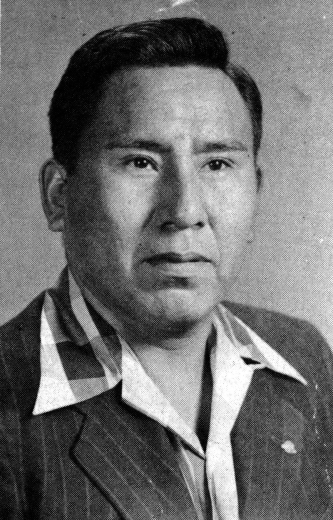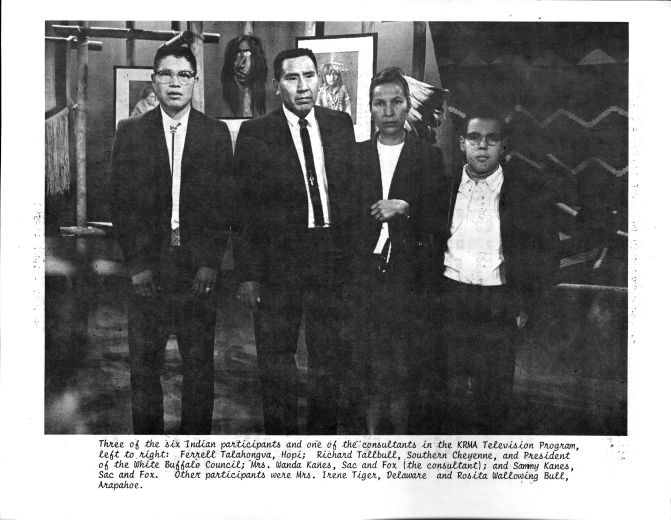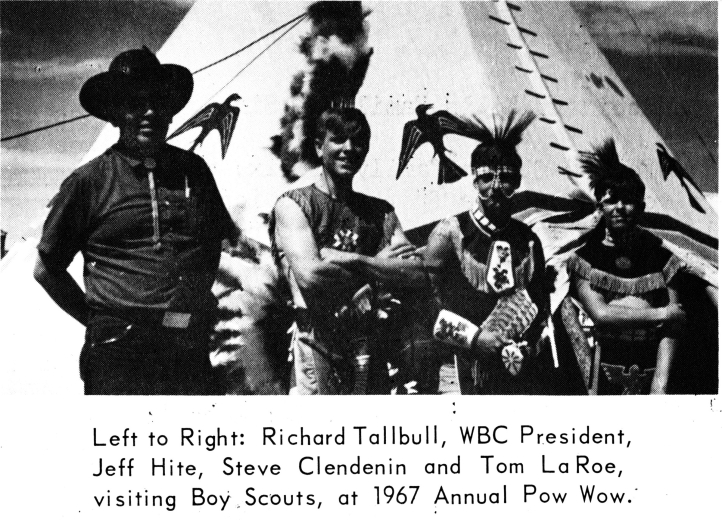Richard Tallbull was a member of the Southern Cheyenne who worked to preserve Native cultures as Native Americans began relocating into the city.
Richard (Carries the Arrow) Tall Bull was born in Clinton, Oklahoma on August 10, 1918, to Clarence Tall Bull and Wannie Tall Bull. After dropping out of 10th grade and enlisting in the military in 1942, he changed his name to Tallbull because the military did not like the use of two words as a last name. He would go by the new version of his name for the rest of his life. In 1961, Richard, his wife Gertrude (Walking Woman) Lonebear, and their three children moved from Thomas, Oklahoma to Denver where he took a job with Landy Manufacturing.
As soon as they moved to Denver, Richard became active in the White Buffalo Society, which worked to serve the needs of the fast-growing local Native American community. Richard’s family and families from many other Tribal nations moved into cities as a result of the Indian Relocation Act. The act intended to offer Native Americans transportation and a few hundred dollars to leave the reservations and move to one of several major U.S. cities. The plan was to eventually empty the reservations and make that land available for sale and development. Not only were these new urban residents coming from rural areas, but many could not read or write in any language, and had experienced crushing poverty. They were being ripped away from their traditional culture and language yet again. With no support network, there was little chance to survive and prosper in a place like Denver without a community group like the White Buffalo Society.
In 1962, the White Buffalo Council worked with the Congress of Racial Equality to organize a boycott of the Denver Dry Goods store for failing to hire a single African-American, Latino, or Asian employee. The Council’s Indian Times newsletter also covered stories important to Native Americans that were largely overlooked in large newspapers, such as the prosecution of Wayne H. Gray for taking several Navajo men from the jail in Gallup, New Mexico, and forcing them to pick piñon nuts in Nucla, Colorado. They promoted local Native businesses like Eberhart’s Western Trading Post. The Council even opened its own small trading post that was open Friday evenings at 31 Broadway, so community members could display and sell their own crafts.
The White Buffalo Council also worked on conservation issues like legal protection of the golden eagle and securing funds for improvements to roads and infrastructure on reservations. They would also hold dinners and dances to raise funds to help local families adjust to life in Denver. The Native community in Denver became widely recognized around the country and, in December 1963, the National Indian Youth Council held their conference here and it included a visit by famous actor Marlon Brando. Richard and the White Buffalo Council didn't just work to improve the lives of their own community, but also served the broader Denver community. They did this through events like performing traditional dances to sick children being treated at National Jewish Hospital and participating in canoe trips on the Platte River meant to promote environmental conservation.
Richard resigned from the presidency of the White Buffalo Council in 1963, but would come back to that role several more times over the following decades. Soon after his first retirement, he went on to serve as the social activities director and Gertrude served as the director of arts and crafts. Both Richard and Gertrude participated in powwows through traditional songs and dances. The couple remained active in the group and, in 1965, Richard began another term as president of the group. In 1965, Richard represented the White Buffalo Council at a meeting of the Latin American Educational Foundation — an organization dedicated to providing educational opportunities to Latino students. The two groups worked to learn strategies from each other and Richard said he was so impressed by the student presentations that he intended to start a scholarship for the group in the name of the White Buffalo Council.
Under Richard’s leadership, the community held regular powwows in which the Native community would perform songs and dances, as well as hold crafting competitions. The powwow was and continues to be a way by which different Native peoples can share their unique traditions as well as preserve those traditions for future generations. In 1974, Richard and other members of the White Buffalo Council worked with Denver Mayor McNichols to establish 60 acres near Daniels Park and the bison preserve to hold powwows and promote Native cultures. The area was named Tall Bull Park after the great Cheyenne chief (Richard’s great-grandfather) who was killed by the U.S. Cavalry in 1869 at Summit Springs, Colorado. At one such powwow in 1980, Richard performed a special sweetgrass prayer ceremony with John Emhoola, for which the Thunderbird Man library branch is now named.
While the Tallbull family had lived in Denver since 1961, Richard and Gertrude regularly visited family in Oklahoma and Montana. While visiting, it was not unusual for them to take part in traditional ceremonies as well as powwows. In 1970, Richard was even made head drummer at the powwow in Colony, Oklahoma. By 1971, he served as the executive director of the same Cheyenne Arapaho powwow in Colony. He also served as president of the Native American Church in Oklahoma, as well as serving as sub-chief for the Dog Soldier Clan of the Southern Cheyenne. He had a strong interest in uniting Native Americans living on the reservations as well as those now living in the cities.
“Let us not widen the gap between those of us ‘on the reservation or in Indian communities’ and those of us in ‘urban areas.’ Our tribal governments could try harder to show their concern for their people living away; at the same time, those of us living away from home could show more respect, understanding, and support for our tribal leaders and governments.” -Richard Tallbull, Indian Times December 1972
Richard also sought to create more understanding between Native Americans, other minorities, and the larger American society. He and Gertrude helped train school teachers and university professors regarding Native society and Native crafts. In 1976, he worked with the Denver Museum of Nature and Science to design an exhibit depicting a Cheyenne camp on the Great Plains. He even oversaw the construction of a traditional teepee within the museum. That same year, he was appointed to Denver Mayor Bill McNichol’s committee to plan the celebration for the 200th anniversary of the United States. His knowledge of Native crafts and practices was so well known that he was even called in to advise archaeologists who had discovered an ancient wooden teepee structure in 1989. In 1999, the Denver Museum of Nature and Science held a Spring Buffalo Feast and Honoring Ceremony in which they invited over 1,000 representatives from Native communities, civil leaders, and members of the museum. At this feast, Richard was given the great honor of the Elder Award.
Three years after being given the Elder Award, Richard died from complications related to diabetes. He never had an abundance of time or money, but what time he had outside of work was devoted to preserving Native cultures and helping the diverse groups that make up Denver respect and understand one another better. He also conveyed the importance of certain traditions to his children and grandchildren who continued to participate in tribal customs and ceremonies after his death.
reservations - land set aside for use by Native Americans after their original lands were taken
boycott - people joining together and agreeing to avoid a person or business because they disapprove of something that person or business is doing
powwow - a Native American social gathering
Have you ever had to move from the country to the city or from one country to another? What kinds of challenges did you face?
Do you think Native Americans working together and sharing their experiences helped them adapt to life in a big city? Why?
If you had to move to a new place how would you go about trying to adapt to the change while also remembering where you came from?





